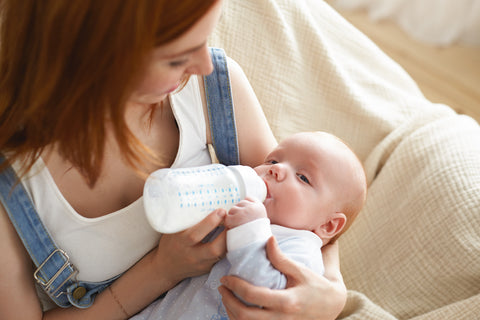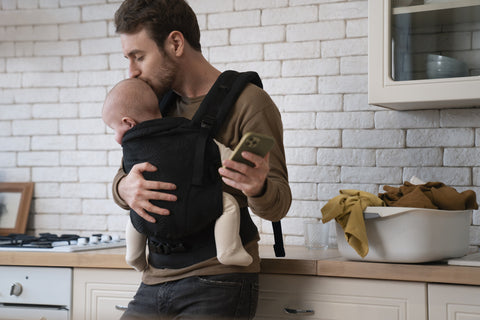Welcome to our comprehensive guide on breastfeeding for infants! Breastfeeding is not just a feeding method; it's a powerful bond between a mother and her baby, providing numerous benefits for both physical and emotional health. In this blog, we'll delve into the wonders of breastfeeding, covering its advantages, things you need to buy for breastfeeding, techniques, common breastfeeding challenges, and helpful tips to make your breastfeeding journey a smooth and rewarding experience.
Section A: Breastfeeding tips for first-time moms
1. When does a mother’s milk supply kick in?
Milk production typically starts around 16 to 22 weeks. This is when your body starts producing colostrum, which is your baby’s first food after birth. It’s usually thick, yellowish in color, and rich in nutrients and antibodies. Colostrum also helps your baby pass their first bowels and prepares their intestines for matured breast milk, which will come later.
Around 3-5 days after your birth, your body will start producing more milk. Some of the signs of your milk coming in are:
- Your breasts becoming bigger and feeling heavier, more full, or engorged
- Your milk no longer coming out in drops, but in leaks and sprays
- Changes in your baby’s feeding patterns
- An increase in the number of dirty diapers
However, in some cases, a mother’s milk may be delayed from coming in. Some of the causes are:
- Stress
- Have a C-section delivery
- Obesity
- Thyroid issues
- Infection or illness with fever
- Excessive bleeding after birth
If you think your milk is delayed, try these tips:
- Get some rest and lots of sleep
- Drink water to stay hydrated
- Continue expressing milk
- Try more skin-on-skin contact with your baby
- Check if your baby is able to latch properly or not
- Seek help and support from a doctor or a lactation nurse.
2. What do I need to buy for nursing?
For expecting parents planning to shop before the baby comes, here is a list of nursing essentials that you need to buy:
- A comforting nursing pillow: A nursing pillow helps elevate your baby’s head and support them.
- A nursing bra: It should be comfy, offer support, and be easy to unlatch whenever you need to nurse.
- Breast pumps: To express breast milk.
- Nipple pads: To soak up any milk that leaks from your breast whenever you’re not nursing your baby.
- Nursing clothes: These are clothes (shirts or dresses) that are comfortable and make it easy for mothers to nurse their babies in.
- Storage bags and containers: You’re gonna need a lot of them to store your breast milk!
- Nursing covers: A thin blanket cover to help you nurse your baby comfortably in public.
- Nipple creams or lotions: Your nipples deserve some TLC too!

Image by Freepik
3. When and how do I start breastfeeding?
Mothers can start breastfeeding as soon as after birth. Usually, within an hour during this period, your baby will be able to feed.
To start breastfeeding, hold your baby against your skin (skin-to-skin contact) and when you’re ready, place your breast in a position that’s comfortable for you and your baby. Guide your baby’s mouth to your nipple and encourage them to latch on to feed.
4. What are the benefits of breastfeeding?
The benefits of breastfeeding for infants…
For infants, it provides the ideal nutrition, perfectly tailored to their needs, promoting healthy growth and development. The antibodies present in breast milk boost their immune system, offering protection against various infections and diseases. Breastfeeding has also been linked to lower rates of Sudden Infant Death Syndrome (SIDS), obesity, and certain chronic conditions later in life.
The benefits of breastfeeding for mothers…
For mothers, breastfeeding stimulates the release of oxytocin, promoting bonding and reducing the risk of postpartum depression. It aids in postpartum weight loss by burning extra calories and reduces the risk of breast and ovarian cancer. Additionally, breastfeeding is convenient, cost-effective, and environmentally friendly, eliminating the need for formula and reducing waste.
5. How do I breastfeed my baby?
Proper breastfeeding techniques are essential for ensuring a successful and comfortable feeding experience for both mother and baby. Here are some tips to help you get started:
- Positioning: Find a comfortable position where you can comfortably support your baby's head and body close to your breast. You can try sitting or lying down.
- Latching: Encourage your baby to open wide and latch onto the entire areola, not just the nipple, to ensure a deep and effective latch.
- Nursing on demand: Feed your baby whenever they show hunger cues, such as rooting, sucking on fists, or crying, rather than following a strict schedule.
- Switching sides: Offer both breasts during each feeding session to ensure adequate milk supply and stimulate milk production.
- Burping: Gently burp your baby midway through and after each feeding to release trapped air and prevent discomfort.
6. How do I know if my baby wants to feed?
Here are some of the signs to know if your baby wants to feed:
- Opening their mouth
- Turning their head from side to side
- Sucking on their hands and fingers
- Becoming more restless or fussy
- Sticking out their tongue
- Nuzzling against your chest
@karissa.mamanursern Newborn feeding cues #newborn #newbornbaby #newbornfeeding #breastfeadingmomma #breastfeeding ♬ Sweet Child O' Mine - Acoustic - Jae Hall
7. How do I know if my baby is full after breastfeeding?
When nursing or breastfeeding your baby, it’s always best to pay attention to their cues to know if they are full after a feed or not.
Your baby will:
- Turn away or push from the breast.
- Close their mouth and open their hands.
- Look relaxed and satisfied after they’re done.
- Not show any more hunger signs.
- Show disinterest if you try to offer more milk.
8. How do I know if my baby is getting enough milk?
Is your baby getting enough milk? Here are some more signs to know:
- Seeing and hearing them suck and swallow while they feed
- They’re calm and relaxed while they feed with rounded cheeks
- They look happy and satisfied after they’re done
- They steadily gain more weight with more feeds after the first 2 weeks
- More diaper changes
- Your breasts are softer after feeds and your nipples don’t change in appearance (i.e. They don’t look pinched or flattened)
- Your baby automatically latches off your breasts after feeds
@kathrynanja Drop a 🦄 if youre #pregnant #pregnancy #breastfeeding ♬ Wii Shop Channel Trap - OSRSBeatz
9. How do I pump breast milk at work?
When you want to start pumping breast milk at work, here are some tips to consider:
- Bring your pumping essentials in a diaper bag, including a nursing cover, a breast pump, storage bags, nipple pads, and an insulated cooler for storage.
- Ask your colleagues where they usually pump their milk at work.
- Find a space at your workplace where you can pump your milk without being disturbed.
- Create a routine by choosing a time of the day to pump, like your baby’s feeding times.
@katbendarez Here’s my pumping essentials 🩵 #pumping #workingmom #breastfeeding #babyproducts #pumpingmom #firsttimemom #momtok #momsoftiktok #boymom #pumpingmom #pumpingessentials #breastfeedingworkingmom #ftm ♬ original sound - Kat
10. When should I stop breastfeeding?
The World Health Organization recommends exclusively breastfeeding for up to 6 months. At the 6-month mark, mothers can slowly start introducing solid foods to their infants while continuing to breastfeed for up to 2 years.
Weaning for nursing mothers usually occurs between 9-12 months, but it’s up to your baby and you to know when you want to stop breastfeeding.
Also read: 8 Tips to Introduce Solid Foods to Toddlers

Image by senivpetro
Section B: Breastfeeding storage guide
11. How do I store my breast milk?
To store your expressed breast milk, wash your hands with soap and water to handle the milk and store your milk in breast milk storage bags or clean food-grade containers. Next, label your bags with the date you expressed the milk, and place them in the back of a refrigerator or freezer. However, if you aren’t able to access either at the moment, store your milk in an insulated cooler with ice packs.
While filling up your bags, stick to an amount that best fits your baby’s feeding portions, and don’t overfill each bag with too much milk. Do keep extra bags of milk on hand for emergencies, like delayed feedings. Don’t add warm breast milk to frozen breast milk or else it will cause the milk to thaw. If you want to add freshly expressed milk to previously frozen milk, make sure it’s cooled enough in the fridge first.
12. How long can I store freshly expressed breast milk?
@helebell511 Replying to @mrsmoran milk storage routine 🍼🫶🏻#newmomtips #newbornbabytips #breastfeedingmom😍😍 #exclusivelypumping #exclusivepumping #momhacks101 #liquidgold #breastmilkstash #pumpingmoms #breastmilkstorage #freezingmilk #milkstoragetips #momtips #milkbricks ♬ Sunny - TELL YOUR STORY music by Ikson™
Freshly expressed breast milk can be stored at room temperature (77°F or colder) for up to four hours, especially if the room is warm. You can also store freshly expressed milk in an insulated cooler for up to a day.
At home, you can store your freshly expressed milk at the back of your refrigerator (40°F) in clean conditions for up to 4 days. However, it’s best to use or freeze the milk within 3 days of expressing the milk. As for the deep freezer (0°F), you can store your milk at the back of the freezer for up to 12 months, but it’s best to use the frozen milk within 6 months.
Whether you’re storing your milk at home in a freezer or a refrigerator, it’s optimal to use up the milk in 3 days or 6 months to make sure the milk doesn’t lose the Vitamin C component for your baby’s nutritional needs.
13. How do I safely thaw my breast milk for my baby?
When you want to use your breast milk, always thaw the oldest breast milk first. Some of the ways you can thaw your milk are:
- Thawing it in the refrigerator overnight (use the milk in 24 hours after completely thawed)
- Setting the milk container or bag in a container of warm or lukewarm water
- Running the bag or container under lukewarm water
Once breast milk is brought to room temperature or warmed, use it within 2 hours.
A couple of don’ts to know:
- Never thaw frozen milk in the microwave: This will destroy the milk’s nutrients and make it too hot for your baby to drink.
- Never refreeze breast milk after it has thawed: This will also destroy the proteins and the good nutrients present in the milk.
@labor_junkie_rn ⚠️my supply is NOT normal and NOT a goal to reach, I simply have an actual genetic propensity to overproduce ⚠️ Everyone talks about pumping and storing Breastmilk, but what about when you’re ready to USE it?! Don’t worry, I got you 😘❤️(CDC, updated January 24,2022) #learnontiktok #birth #postpartum #breastfeed #pumpingmom ♬ BIG MAD - Ktlyn
Section C: Common breastfeeding challenges and solutions

Image by shurkin_son
14. What are common breastfeeding problems?
While breastfeeding is natural, it can also present challenges that may require patience and support to overcome.
Some common breastfeeding problems include
- Engorgement: If your breasts become engorged and painful, apply warm compresses before feeding and express a small amount of milk by hand to soften the breast.
- Sore nipples: Use lanolin cream or breast milk to soothe sore nipples, and ensure a proper latch to prevent further irritation. In this case, you can consider getting breast shells to help protect your sore nipples from friction against clothes.
- Low milk supply: Stay hydrated, eat a balanced diet, and nurse frequently to stimulate milk production. You can also try herbal supplements or consult a lactation consultant for assistance.
- Mastitis: This is an inflammation of the breast tissue, often accompanied by flu-like symptoms. Rest, apply warm compresses, and continue breastfeeding to alleviate symptoms, but seek medical attention if they persist.
- Latch Issues: If your baby struggles to latch properly, seek guidance from a lactation consultant who can offer personalized support and advice. You can also consider getting nipple shields as they mimic the shape of a nipple and can aid better breastfeeding.
15. What is mastitis?
Mastitis is one of the biggest concerns for nursing mothers — this is an inflammation of breast tissue that sometimes involves an infection. It causes breast pain, swelling, warmth, and redness. In some cases, mothers might also have fever and chills, and it may also cause early weaning.
Causes of mastitis
A cause of mastitis is a blocked milk duct that becomes clogged after incomplete feedings. When more milk becomes backed up, it causes an infection. Another cause of mastitis is bacteria from your skin’s surface or your baby’s mouth. Stagnant milk in a breast that isn’t emptied can be a breeding ground for bacteria that enter through milk duct openings and through cracks in your nipple’s skin.
Some of the risks of mastitis include
- Sore or cracked nipples
- Wearing a tight-fitting bra
- Poor nutrition
- Stress and feeling overtired
- Improper nursing techniques
Symptoms of mastitis
- Breast tenderness and warmness to the touch
- Swelling breasts, thickening of breast tissues or a breast lump
- Pain or a burning sensation while nursing
- Skin redness that appears in a wedge-shaped pattern
- Feeling ill
- A fever of 101°F or greater
How do I treat mastitis?
Doctors will usually prescribe painkillers and antibiotics to treat mastitis, but in more severe cases, it may cause medical complications that will require medical interventions.
To prevent mastitis, you can make sure the milk is completely drained during feedings and pumpings. Let your baby completely empty one breast before moving on to the next, and occasionally change the feeding position while you’re nursing. Most importantly, make sure your baby latches onto the nipple properly while they feed.

Image by freepic.diller
16. What is breast engorgement?
Another challenge mothers face while nursing is breast engorgement as their milk comes in.
It’s caused by increased blood flow and lymph fluids into your breast to support lactation. As a result, the lower part of your breasts will feel swollen and painful. Other possible symptoms of engorgement may include fever and chills in more severe cases, and breasts that feel firm or hard.
Breast engorgement may occur 3-5 days after giving birth with the changes in milk production, but in some cases, engorgement can occur on days 9-10 postpartum.
How do I treat breast engorgement?
There are several ways you can treat breast engorgement for nursing mothers. Healthcare providers may prescribe medication like ibuprofen or try lymphatic drainage massages. They may also recommend a few other solutions like
- Reverse pressure softening for 1-3 minutes (applying gentle, steady pressure in the area around your areola).
- Trying a different breastfeeding position (e.g. lying on your side while breastfeeding).
- Applying cold packs or tucking clean cabbage leaves under your bra to relieve inflammation.
- Wearing a supportive and properly fitted nursing bra with no wires (or going braless!).
- Gently expressing milk before and after breastfeeding.
17. What is cluster feeding?
Cluster feeding is when your newborn baby wants more feeds over a period of few hours. Although it can happen at any time of the day, it usually happens in the late afternoon or early evening.
Your baby will:
- Have short rests or sleep between these feeds
- Feeds for a few minutes before pulling off and on the breast
- Cry and is fussy during cluster feeding.
Cluster feeding can be draining emotionally and physically, so it’s important to seek help and guidance from the doctor and your loved ones. Some of the ways you can make cluster feeding easier are to...
- Relax and follow your baby’s lead
- Feed to their needs
- Rest in the early part of the day to prepare
- Drink lots of water to stay hydrated
- Eat well and don’t miss meals
Section D: How can you help your breastfeeding partner?

Image by Freepik
When you’re a parent nursing their baby, you need all the help you can get.
Some of the ways your partner can help while you’re breastfeeding include:
- Offering support and encouragement.
- Learning the basics of breastfeeding so they can anticipate the mother’s needs.
- Helping take care of the baby with essential tasks like diaper changes, feedings, grocery runs, errands, bottle feeding, house chores, and more.
- Keep your breastfeeding partner company while they pump or feed.
- Watching out for hunger cues and offering to bottle feed the baby.
- Taking care of the mother after feedings by offering snacks and water and letting her sleep.
- Limiting the amount of visitors while the mother recuperates.
- Talking to other dads or moms for help and advice.
Breastfeeding is a beautiful and natural way to nourish your baby and provide countless benefits for their health. With these tips and insights, you can embark on a rewarding nursing journey that will strengthen the bond between you and your little miracle.
















